Following a gap of almost a year due to the 2013 Sequestration budget cuts, the USAF’s Red Flag training exercises have returned with a new and improved version. Chris Wood reports from Nellis AFB, on the outskirts of Las Vegas, on the first of three exercises in fiscal year 2014. Red Flag 14-1 ran for three weeks between the 27 January and 14 February. Additional photography by Gordon Jones.
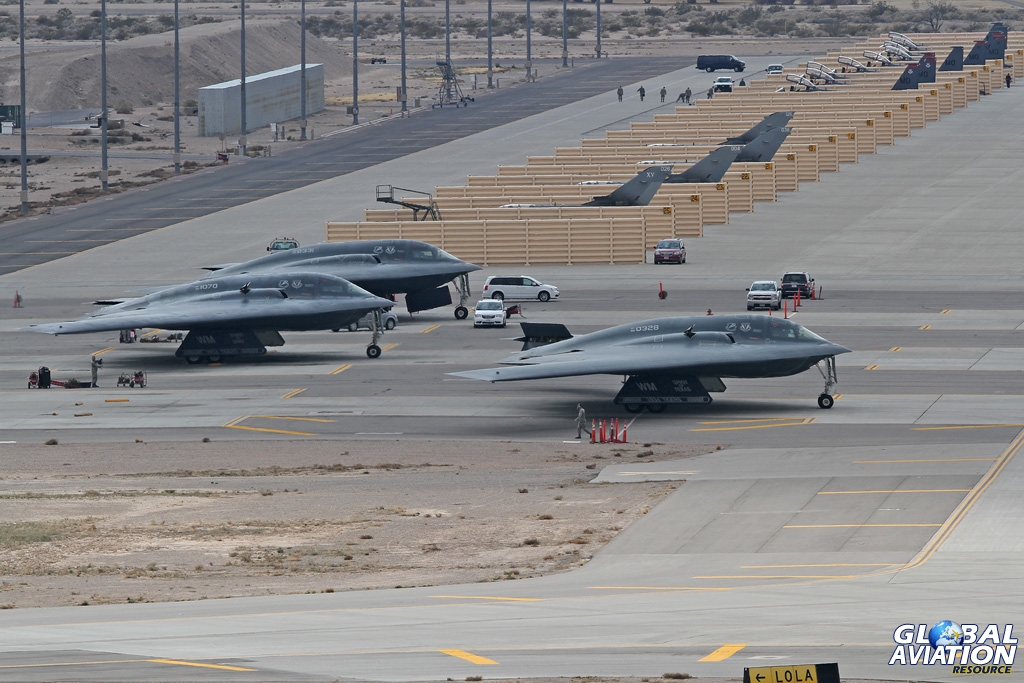
Red Flag is a US exercise, but normally includes coalition partners and can feature a wide variety of aircraft types © Chris Wood – www.globalaviationresource.com
Red Flag is the United States Air Force’s (USAF) premier combat training exercise, whose aim is to provide realistic and relevant combat training to all branches of the US military and its allies using air, space and cyberspace forces.
The need for realistic combat training was realised during the Vietnam War when the US kill ratio dropped to two-to-one, compared to the ten-to-one ratio of the Korean War. It also became apparent that most pilots were being shot down during their first ten sorties, so a program was devised to replicate these first ten combat missions before the crews saw any real action.
This programme, known as Red Flag, started at Nellis in 1975 and is still going strong. Today, it is run by the 414th Combat Training Squadron (CTS), which is assigned to the US Air Force Warfare Center (USAFWC) through the 57th Wing, based at Nellis, and the exercises take place over the 15,000 square miles of the Nevada Test and Training Range (NTTR) which lies to the north of Nellis.

An Aggressor F-15C heads to the ranges © Chris Wood – www.globalaviationresource.com
Having started as primarily an air-to-air exercise, it has evolved over the years and now encompasses all possible types of mission, from air interdiction (AI – planned bombing of targets not in close proximity to friendly forces) to close air support (CAS – targets in close proximity to friendly forces, requiring special coordination with ground forces), offensive counter air (OCA – attacking enemy air assets on or close to the ground), defensive counter air (DCA – air-to-air), dynamic targeting (DT – unplanned targets) and combat search and rescue (CSAR – rescuing aircrew from behind enemy lines).
Consequently all the aircraft in the US inventory can appear at Red Flag, and coalition partners can add other types to the mix, including types that may be found on opposing sides in real world combat. Units deploy to Nellis using the Air Expeditionary Force concept and they make up the “Blue” forces. Over the course of the exercise, they can expect to find themselves used in a variety of different roles; OCA, DCA, AI and CAS and they can also expect to drop live weapons.

Live weapon drops are a regular feature at Red Flag © Chris Wood – www.globalaviationresource.com
There are a wide variety of targets in the NTTR, ranging from airfields with aircraft, tanks, vehicle convoys, bunkered defensive positions and missile sites. Defending them are the “Red” forces, controlled by the 57th Adversary Tactics Group (ATG) based at Nellis. According to Major Eric “Yogi” Flatter, the 57th ATG Chief of Weapons, his job is to “use your tax dollars to become the best bad guy that the Blue forces can go up against”. To achieve that the 57th ATG comprises seven Aggressor Squadrons (AGRS) of which only two operate aircraft: the 64th AGRS flying the F-16C Fighting Falcon and the 65th AGRS flying the F-15C Eagle. The other squadrons provide Aggressor radar, cyberspace, space and information operations.
The exercises are planned, developed and executed by the Intelligence Operations Flight of the 547th Intelligence Squadron. They create exercise scenarios and also train and evaluate unit level intelligence skills and processes of all US and Allied exercise participants.
The exercises are run on a day-to-day basis by the “White” force. They use the Nellis Air Combat Training System (NACTS), the world’s most sophisticated tracking system for combat training exercises, which allows real time monitoring of the simulated combat between the Red and Blue forces. All the aircraft carry telemetry pods which relay information back to NACTS, allowing it to calculate whether or not attacks are successful, as they happen. NACTS is also used for the subsequent debriefing.
Normally two missions are flown every weekday for the duration of the exercise, comprising a day mission and a night mission, and most exercises run for two weeks allowing ten flying days.

Half the missions are flown in daylight © Chris Wood – www.globalaviationresource.com
According to the 414th CTS Deputy Commander, Lt Col Jordan “Gadget” Grant, the big change that has been made from previous exercises is that the missions are now more joined up. Over the last 40 years, “every day at Red Flag was a new war” replicating the initial days of a war as they are the most intense, and “what happened on Monday didn’t affect Wednesday or Thursday”. However, the training audience has developed beyond the junior fighter pilot, referred to as “Blue Four” (number four in a flight of four) and now includes the ISR (Intelligence, Surveillance, Reconnaissance) world, which is needed to fight a modern war. They have specific training needs which mean the simulated war needs some level of continuity between Monday and Friday, so whilst 80% is still new each day the scenarios are linked, providing the needed continuity.
A lot of time and effort has been put in to achieve consistency so that the war makes sense to the Blue forces from Monday to Friday. However, there are controls in place as the mission results are not guaranteed, they are built for a pass or fail depending on how the participants performed, so the scenarios are created with back up plans.
Capt Hayley “Zap” Hartstein from the 547th Intelligence Squadron had a key role in devising the new Red Flag. She describes it as “not your father’s war, it’s not even your slightly older brother’s Red Flag, it’s all brand new”. During the down time one of the objectives was to “work with other domains [such as the space and cyber forces] to see what they can bring to the table to make the tactical fighter more effective and [increase his chances of] survival”.
Another big change is that the NTTR now only represents one province of the enemy territory. Whilst the air operations still occur over the NTTR, events can be simulated outside that area which will have an impact on the air operations.

An Aggressor F-16C heads for the ranges © Gordon Jones – www.globalaviationresource.com
Most of the aircraft launch from Nellis, although occasionally aircraft from other bases will take part. Lt Col Grant stressed that this is the exception to the rule and is discouraged as the briefing and debriefing process provide the opportunity for face-to-face contact and a free flow of ideas, which isn’t possible with crews who aren’t gathered together.
Each mission generally follows a similar pattern, which mission planning starting some 36 hours before launch when an Air Tasking Order (ATO) is issued. This will detail items such as the tasking for each unit, how many aircraft they’ll use and the rules of engagement. Each mission has a designated Mission Commander, who could be from any of the participating forces, and they are responsible for mission planning and execution. The Blue force is divided into groups for each role, known as “packages” (such as the air-to-air package), and each package will have a Package Commander. As this is very much a team effort the Mission Commander will meet with the Package Commanders to get their advice on how best to utilise their assets to achieve the mission goals.
On the morning of the mission all the crews gather for a mass briefing several hours before launch. This will include a reminder of the rules, the enemy’s capabilities and the weather. The Mission Commander will also give a detailed brief about the mission objectives and the methods for achieving them. After the main briefing each unit will have its own briefing on how to achieve its individual objectives, they’ll then head out to the flightline to prepare their aircraft for departure.
The launch takes a significant time and requires a lot of coordination as there can be upwards of 100 aircraft involved, operating from both of the Nellis runways. The first aircraft airborne are usually the “heavies”, comprising the Airborne Warning and Control System (AWACS) aircraft, the air-to-air refuelling tankers and the heavy bombers. For departures and arrivals by B-2As the runway cables are de-rigged, putting that runway (usually 3R/21L) out of action for a short period of time. All the aircraft are marshalled into their respective start areas, with the Red forces on the west side of the NTTR and the Blue to the east with each force being refuelled by their respective tankers.

Off to the ranges © Gordon Jones – www.globalaviationresource.com
The first action usually sees the air-to-air assets taking on the Red fighter aircraft to gain control of the airspace. This is followed by the Suppression of Enemy Air Defences (SEAD) aircraft attacking the Red force defences prior to the strike aircraft attacking their targets. If any aircrew are shot down then a CSAR mission will be launched to rescue them. Usually an aircrew member is picked to play the role of a downed airman, and is flown out to the NTTR to simulate being shot down.
When the mission is complete the aircraft recover to Nellis and the crews gather for a debriefing to go through the mission in fine detail, using the NACTS, to see what lessons can be learned.
Red Flag 14-1 was a big exercise with over 100 aircraft deploying to Nellis. As well as the USAF there were participants from the US Navy and the US Marine Corps, whilst overseas participation came from the UK’s Royal Air Force and the Royal Australian Air Force.
The Air Expeditionary Wing totalled 3,200 personnel and was commanded by Col. Christopher M. Short, the commander of the 366th Fighter Wing at Mountain Home AFB. His deputy was Group Captain Mark Jeffery RAF, who described Red Flag as “the best of the best doing what they need to do to be prepared for what could happen anywhere in the world”. The 2,000 strong Maintenance Group was commanded by Lt. Col. Tony Lombardo, also from Mountain Home.

The 366th Fighter Wing Commanders aircraft returns after a mission © Chris Wood – www.globalaviationresource.com
Making up the Blue force were the following units. On occasions some of these aircraft were assigned to the Red force, for example Mondays were DCA days and saw some big air-to-air battles, described by Major Flatter as “Battle of Britain” days.
Providing the main air-to-air forces were:
27th Fighter Squadron, 1st Fighter Wing , Joint Base Langley-Eustis, Virginia
The “Fighting Eagles”, which has the first operational F-22A Raptor squadron, sent 12 aircraft to Nellis.
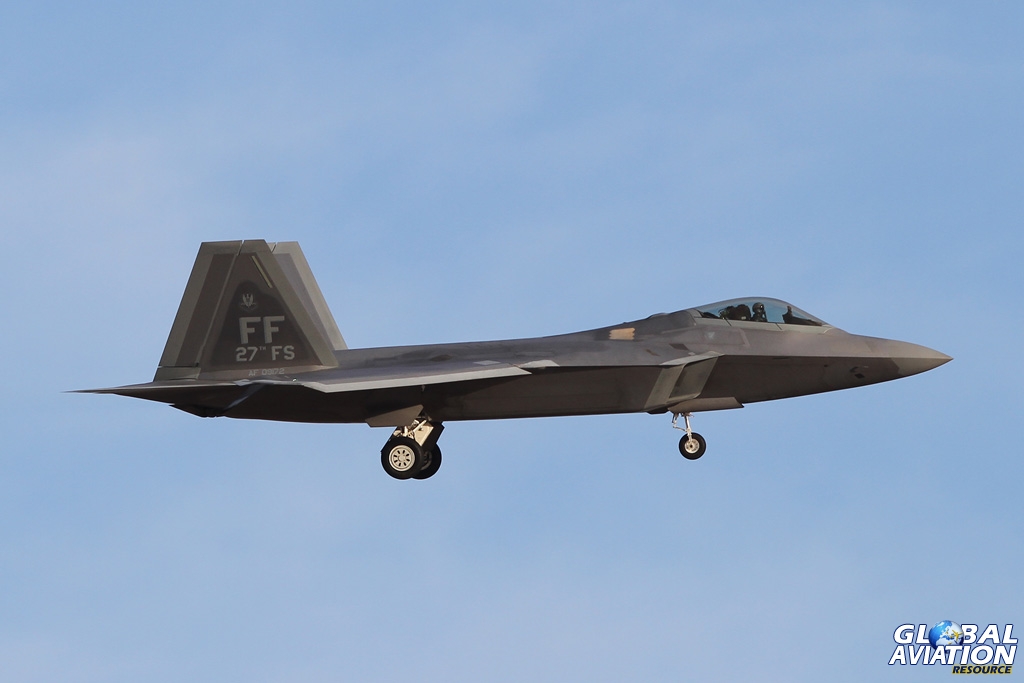
The 27th Fighter Squadron Commanders aircraft heads for the runway © Chris Wood – www.globalaviationresource.com
No 1(F) and No 6 Squadron, Royal Air Force, RAF Leuchars
The RAF brought eight Tranche 2 Typhoon FGR4s for the type’s second appearance at Red Flag, following the Typhoon’s début in Red Flag 13-3 with Tranche 1 aircraft operated by No 11 Squadron. They were used in the swing role, both air-to-ground and air-to-air.

Seven of the Typhoons carried the markings of No 6 Squadron © Chris Wood – www.globalaviationresource.com
According to Group Captain Jeffery, the main benefit of being at Red Flag for the Typhoon force is the opportunity to integrate fourth and fifth generation aircraft by operating with the F-22s, to develop tactics and procedures to maximise their capabilities.

… and one the markings No 1 (F) Squadron © Chris Wood – www.globalaviationresource.com
Available to operate in a mix of roles were:
120th Fighter Squadron, 140th Fighter Wing, Colorado Air National Guard, Buckley AFB, Colorado

The “Mile High Militia” brought seven of its F-16Cs Fighting Falcons to Nellis © Gordon Jones – www.globalaviationresource.com
VMFA-314, MCAS Miramar, California

The “Black Knights” brought eight legacy Hornets, a mix of A and C models © Chris Wood – www.globalaviationresource.com
77 Squadron, Royal Australian Air Force, RAAF Williamtown
77 Squadron operates what the Australians refer to as the “Classic” Hornet in the shape of the F/A-18A and despatched eight aircraft, leaving one behind in Guam. The aircraft carried the markings of a mix of different squadrons. Tanker support was provided by a pair of USAF KC-10s with stops in Guam and Hawaii for the over 20 hour flight to Nevada.

A pair of No 77 Squadron Hornets get airborne © Chris Wood – www.globalaviationresource.com
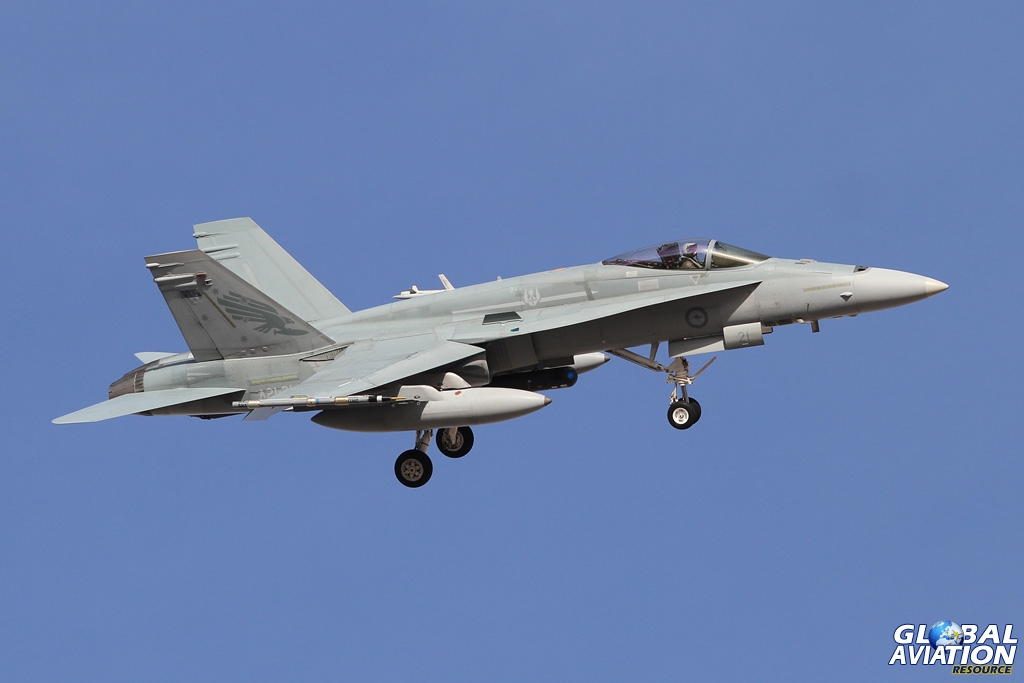
This RAAF Hornet wears the markings of No 3 Squadron © Chris Wood – www.globalaviationresource.com
391st Fighter Squadron, 366th Fighter Wing, Mountain Home AFB, Idaho.
The “Bold Tigers” brought 12 F-15E Strike Eagles to Red Flag.
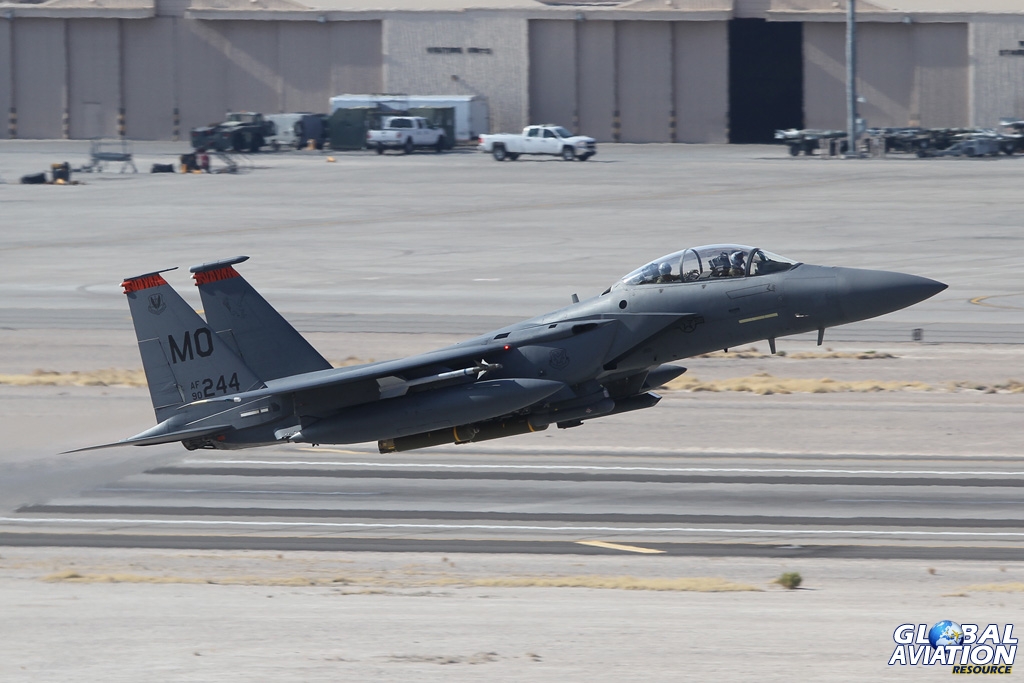
Off to the ranges with live weapons © Chris Wood – www.globalaviationresource.com
No IX(B) Squadron, Royal Air Force, RAF Marham
No 9 Squadron despatched eight Tornado GR4s, although only seven got as far as Nellis, with the eighth remaining in Bermuda with a technical problem.
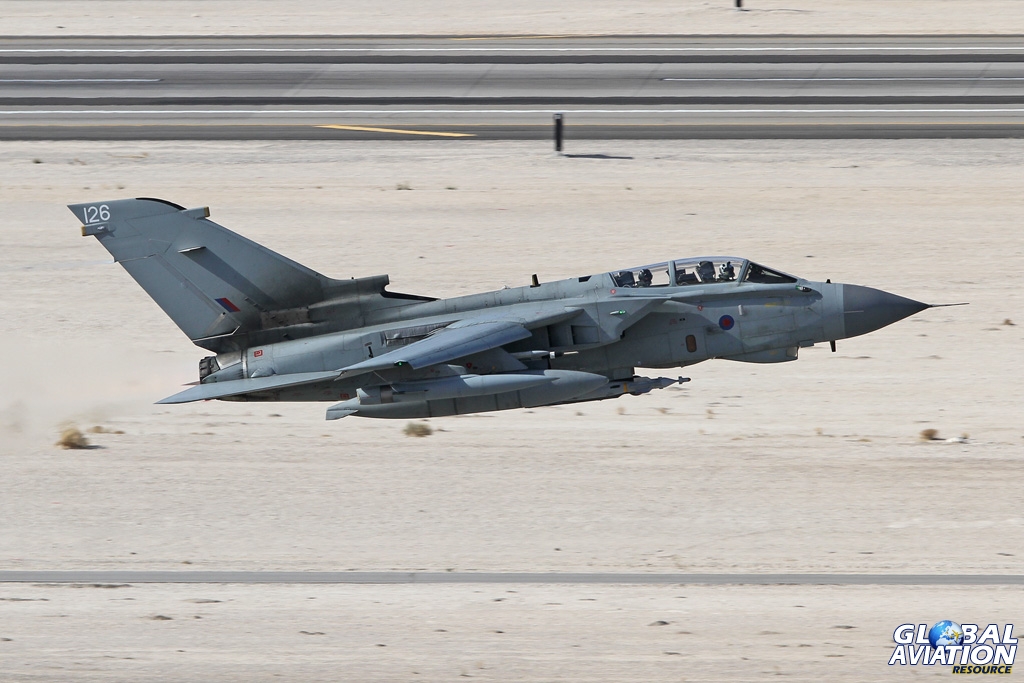
A Tornado heads to the ranges carrying a live Paveway laser guided bomb © Chris Wood – www.globalaviationresource.com
VX-31 NAWC China Lake, California
The “Dust Devils” mix of Super Hornets, a single F/A-18E, four F/A-18Fs and a single EA-18G Growler were a surprise addition to the exercise.

A Dust Devils F/A-18F Super Hornet tucks up its gear © Chris Wood – www.globalaviationresource.com

The Dust Devils Growler turns finals whilst a pair of VAQ-135 Growlers run in to the overhead © Chris Wood – www.globalaviationresource.com

The VX-31 Commanders aircraft, the single F/A-18E at Nellis, turning finals for runway 21R © Chris Wood – www.globalaviationresource.com
13th Bomb Squadron, 509th Bomb Wing Whiteman AFB, Missouri
The “Reapers” brought three B-2As Spirits to Nellis.

“Spirit of Texas” heads to the NTTR © Chris Wood – www.globalaviationresource.com
55th Fighter Squadron, 20th Fighter Wing Shaw AFB, South Carolina
The “Shooters “ deployed to Nellis with a total of 12 F-16Cs and a pair of F-16Ds, although the aircraft were drawn from the 55th and the 77th Fighter Squadrons.

Half of the aircraft carried 55th FS markings © Chris Wood – www.globalaviationresource.com
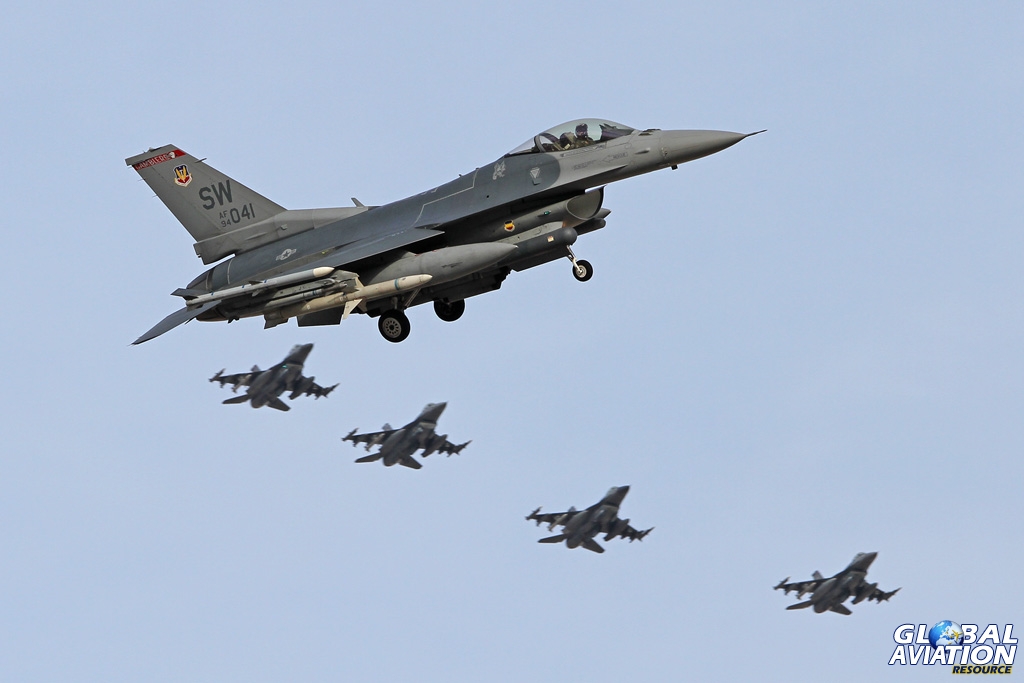
The other half carried the markings of the 77th FS © Chris Wood – www.globalaviationresource.com
For electronic warfare:
VAQ-135, NAS Whidbey Island, Washington

EA-18G Growler VAQ-135 © Gordon Jones – www.globalaviationresource.com

EA-18G Growler VAQ-135 © Gordon Jones – www.globalaviationresource.com
VAQ-132 was listed for the exercise but the aircraft at Nellis were from VAQ-135, the “Black Ravens”. The unit transitioned to the EA-18G Growler in 2010 and became an expeditionary squadron. No strangers to Nellis having participated in previous Red Flags, most recently in Red Flag 13-3, the Black Ravens brought four aircraft and were employed in the SEAD role.
VMAQ-4 MCAS Cherry Point, North Carolina
The “Seahawks” added to the SEAD forces with four EA-6B Prowlers.

Prowlers are becoming a rare sight © Chris Wood – www.globalaviationresource.com

One of the few units to do a pairs departure © Chris Wood – www.globalaviationresource.com
43rd Electronic Combat Squadron, 55th Electronic Group, Davis-Monthan AFB, Arizona
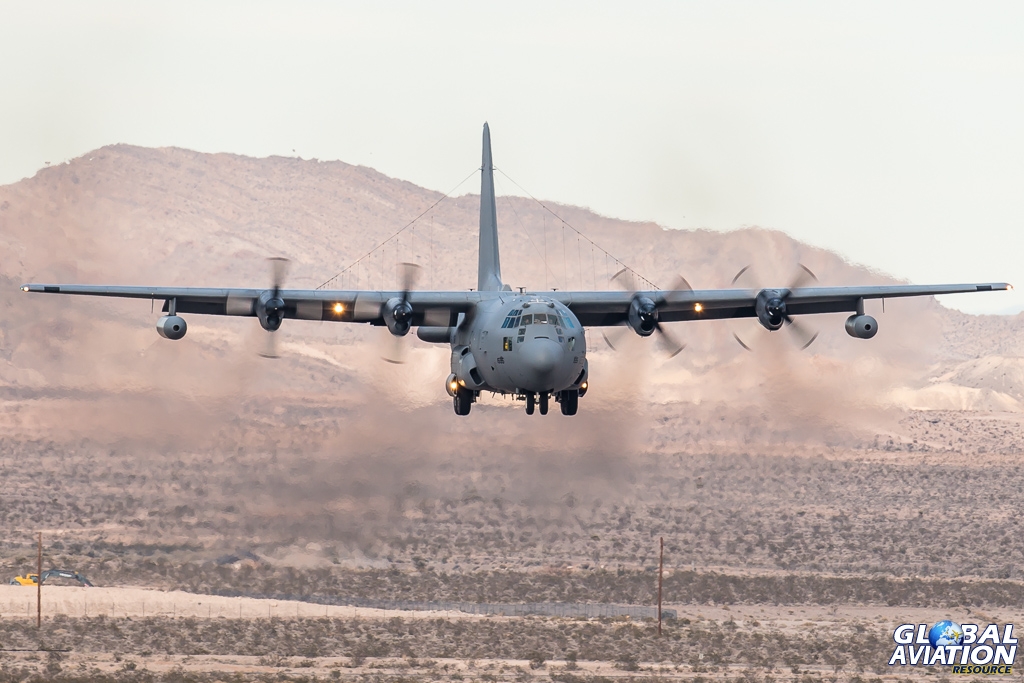
EC-130H © Gordon Jones – www.globalaviationresource.com
The 43rd ECS brought a pair of EC-130H Compass Call aircraft to Nellis, which operated with both Blue and Red forces.
The AWACS force comprised:
964th Airborne Air Control Squadron, 552nd Air Control Wing, Tinker AFB, Oklahoma
Two E-3B Sentrys.
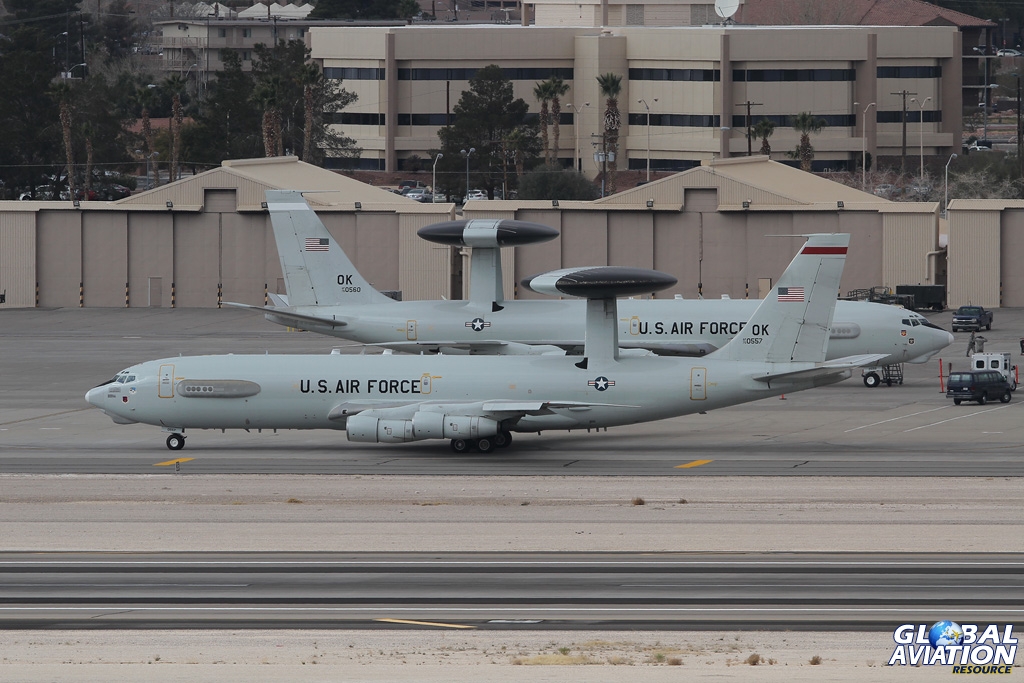
One E-3B taxies past the other as it heads for the runway © Chris Wood – www.globalaviationresource.com
No 8 Squadron, Royal Air Force, RAF Waddington
One E-3D Sentry AEW1.
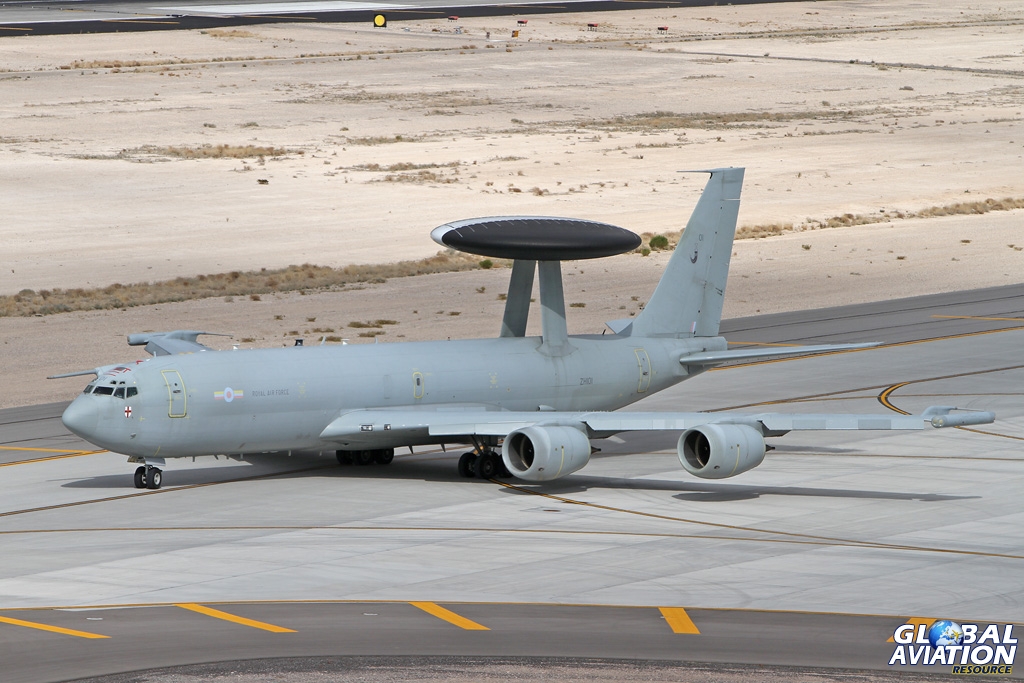
© Chris Wood – www.globalaviationresource.com
2 Squadron, Royal Australian Air Force, RAAF Williamtown
Another type that debuted at Red Flag 13-3 was the RAAF’s Boeing E-7A Wedgetail. The squadron returned this year with one aircraft.
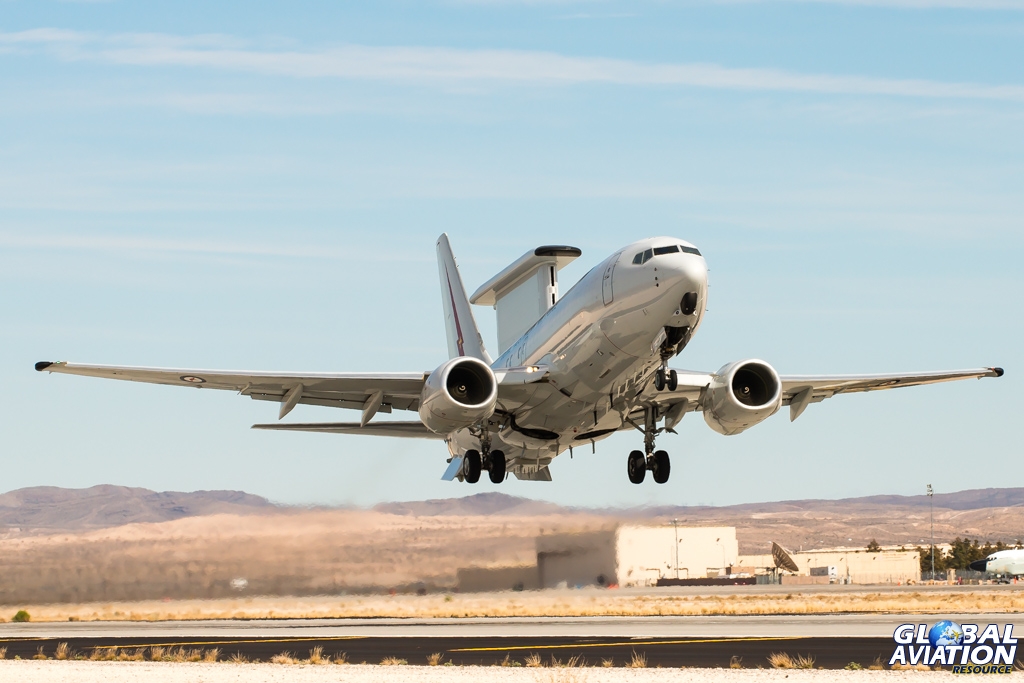
E-7A Wedgetail © Gordon Jones – www.globalaviationresource.com
The number of AWACS assets taking part in the missions varied from none to three.
Other ISR assets, which operated predominantly at night, included:
16th Airborne Command and Control Squadron, 116th Air Control Wing, Robins AFB, Georgia
One E-8C JSTARS

A trio of Boeing 707s and derivatives, still going strong, the E-8C parked next to the RAF Sentry AEW1 and the RC-135W © Chris Wood – www.globalaviationresource.com
38th Reconnaissance Squadron, 55th Wing, Offutt AFB, Nebraska
One RC-135W Rivet Joint

The RC-135W Rivet Joint only flew at night © Gordon Jones – www.globalaviationresource.com
VQ-1 NAS Whidbey Island, Washington
A single EP-3E.

Another night bird, the EP-3E © Gordon Jones – www.globalaviationresource.com
VP-40 NAS Whidbey Island, Washington
A single P-3C fitted with the Littoral Surveillance Radar System (LSRS).
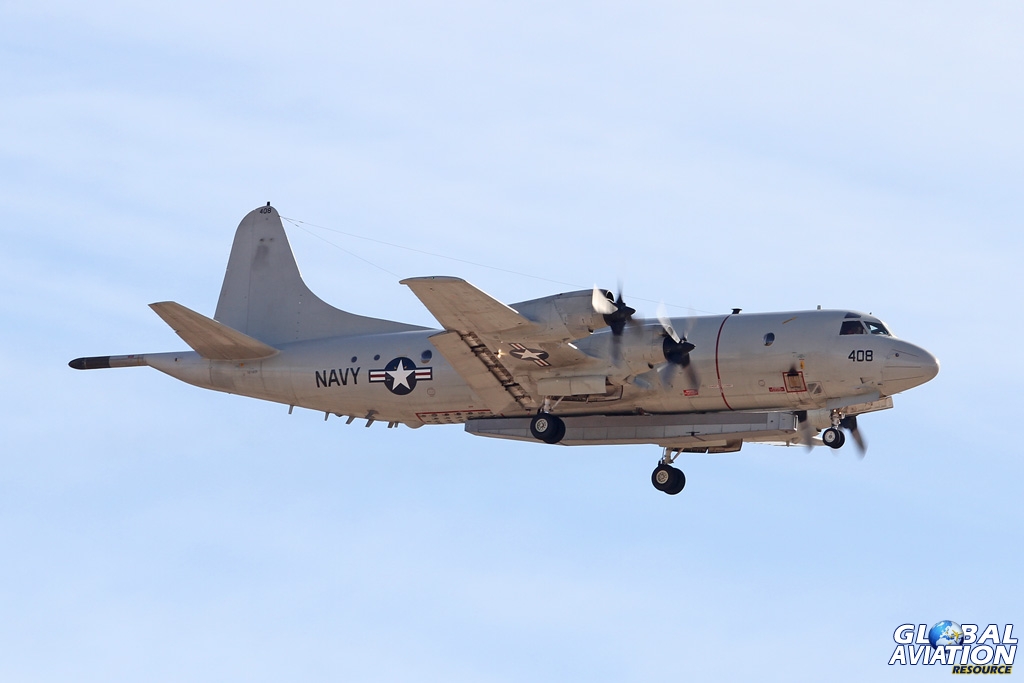
The LSRS equipped P-3C only flew missions at night, but was caught returning from a short test flight one morning © Chris Wood – www.globalaviationresource.com
9th Reconnaissance Wing, Beale AFB, California
A single MC-12W Liberty
41st Rescue Squadron, 23rd Wing, Davis-Monthan AFB, Arizona
The 41st RQS flying the HH-60G Pavehawk was listed for the exercise.

HH-60G Pavehawk © Gordon Jones – www.globalaviationresource.com

A Pavehawk lifts on its way to the ranges © Chris Wood – www.globalaviationresource.com
71st Rescue Squadron, 23rd Wing, Moody AFB Georgi
The 71st RQS brought a pair of HC-130P King aircraft to Nellis, and like the ISR assets only flew at night

More night birds, a pair of HC-130Ps © Chris Wood – www.globalaviationresource.com

© Chris Wood – www.globalaviationresource.com
22nd Air Refuelling Wing, McConnell AFB, Kansas, 92nd Air Refuelling Wing, Fairchild AFB, Washington
The tanker force for the exercise consisted of four KC-135Rs, two from the 22nd ARW and two from the 92nd ARW. Typically one tanker would be assigned as the Red force tanker for each mission, and two for the Blue force. One aircraft was fitted with the Multi Point Refueling System (MPRS) pods, allowing it to refuel the US Navy and Marine Corps aircraft as well as the non-US aircraft that were unable to use the boom.

The MPRS fitted tanker gets airborne © Chris Wood – www.globalaviationresource.com
GAR joined the crew of ENCO 46 for a mission over the NTTR during the course of the exercise. When the aircraft arrive at Nellis they come under the control of the Red Flag organisation and the assets are pooled. Consequently, whilst the aircraft was assigned to the 22nd ARW at McConnell it was flown by a 92nd Air Refueling Squadron crew from the 92nd ARW at Fairchild. The aircraft was a KC-135R fitted with a pair of MPRS pods, flown by Capts James Nussey and Trisden Wright, with Senior Airman Josh Ortega on the boom.

KC-135R 61-0311 sits on the Nellis ramp awaiting its crew © Chris Wood – www.globalaviationresource.com

The crew of ENCO 46 © Chris Wood – www.globalaviationresource.com
The tanker aircraft are amongst the first to get airborne and ENCO 46 was off the ground at 1250, in company with the other blue tanker ENCO 45, on its way to the NTTR.

Waiting for customers © Chris Wood – www.globalaviationresource.com
Once established in the area it wasn’t long before the first customer was on its way in the shape of a USMC EA-6B Prowler, which used the left hand MPRS pod.
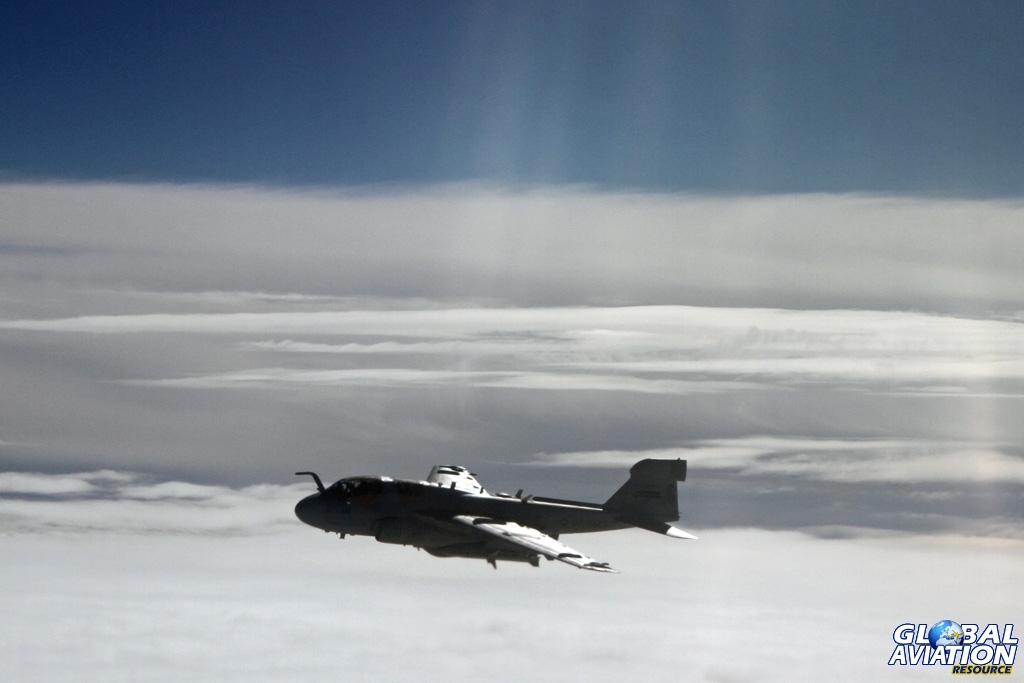
A VMAQ-4 Prowler departs after refuelling © Chris Wood – www.globalaviationresource.com
Next up, and waiting for the Prowler to clear, was a trio of 20th Fighter Wing F-16Cs who used the boom.
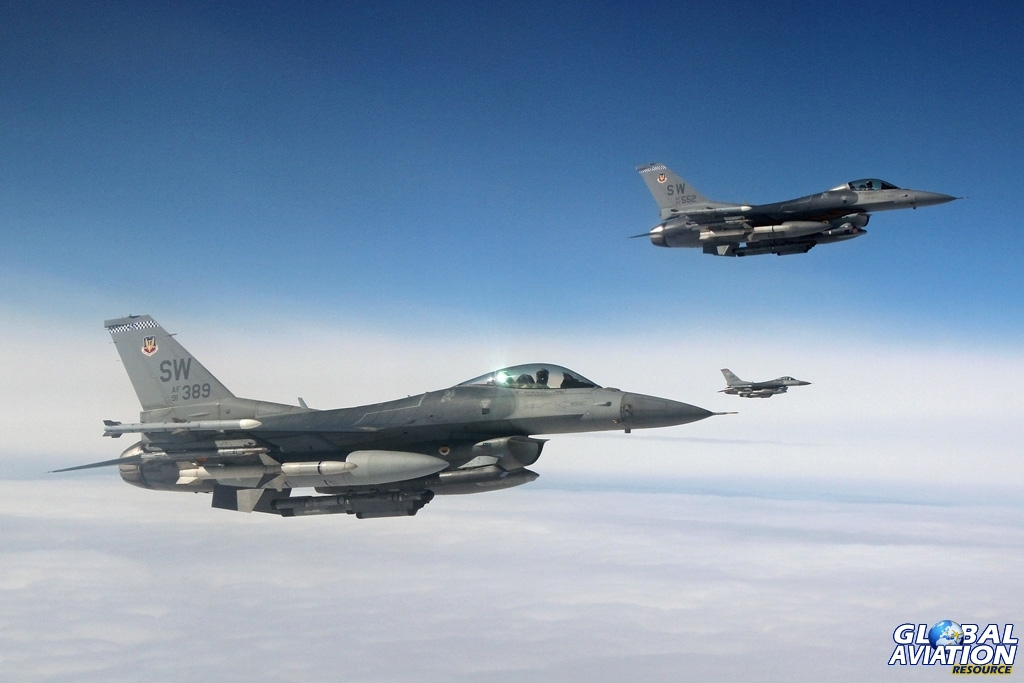
Waiting for the Prowler to depart © Chris Wood – www.globalaviationresource.com

Time for the Boomer to get busy © Chris Wood – www.globalaviationresource.com

A 20th Fighter Wing F-16C plugs in to the boom © Chris Wood – www.globalaviationresource.com
As soon as they had finished it was back to the MPRS pods for a pair of RAAF Hornets, one on each pod.

A pair of RAAF Hornets formate with the tanker before departing back to the fight © Chris Wood – www.globalaviationresource.com
There was then a bit of a gap before a pair of RAF Typhoons appeared and the drogues were reeled out again.

Plugged in © Chris Wood – www.globalaviationresource.com
The Typhoons were finished by 1500 and although more trade was expected the weather over the NTTR, solid, thick cloud cover, curtailed some of the missions, so the Typhoons were the last.

Ready to return to the fight © Chris Wood – www.globalaviationresource.com
ENCO 45’s trade consisted solely of Raptors, with them refuelling a total of eight.
With refuelling complete it was back to Nellis, touching down at 1625.
Red Flag 14-2 is planned to start on Monday 3 March for two weeks. Red Flag 14-3 is planned for July, although the dates and participants are not finalised yet. Look out for reports on these exercises.
The authors would like to thank Major Theresa Sullivan and all the 99th ABW Public Affairs staff for their assistance with this article.






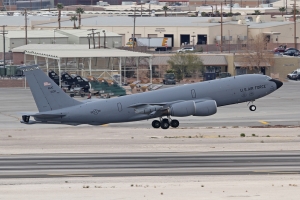

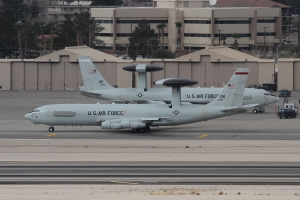
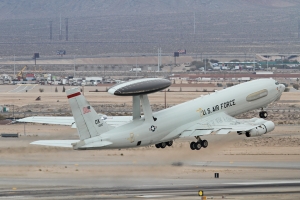
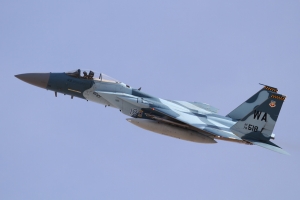
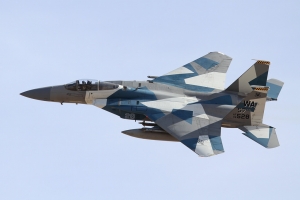
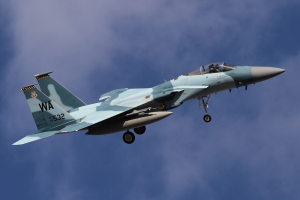
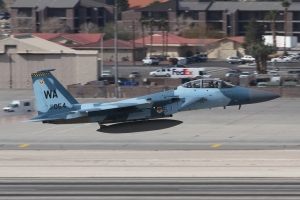

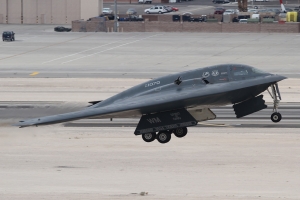

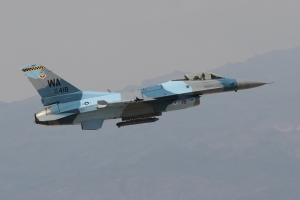

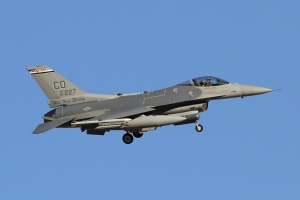
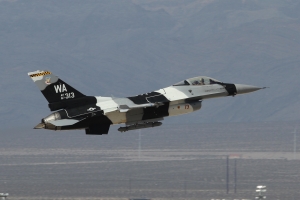


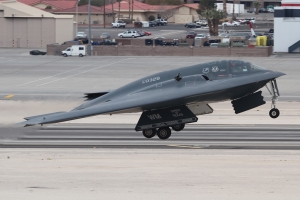

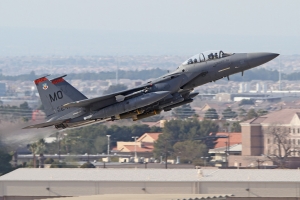
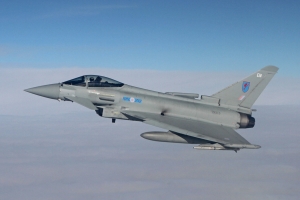
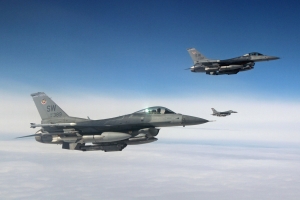


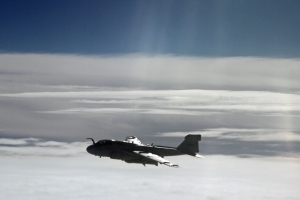


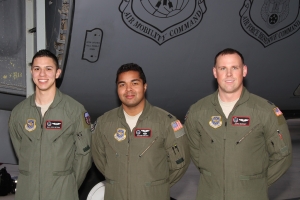


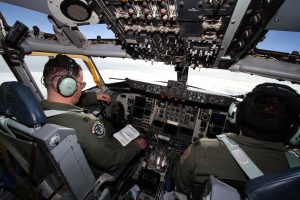
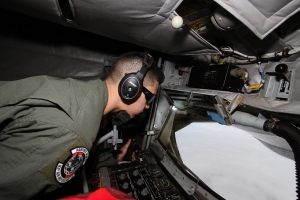

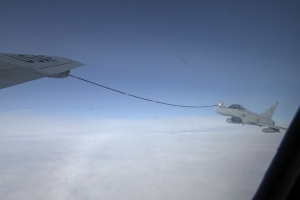







Enjoyed the text summary and recap. I attended RF 14-2, this is my gallery from that EX – http://bluesky.zenfolio.com/p886478801
Nice article, well written! I liked the shot of the 2 F-18s taking off. When I was at RF 14-1 I noticed they never flew that third B-2. I also liked the shots you got of the Fighters with other airplanes flying in formation in the background. Great work. Your pictures of the Prowlers turned out better than mine 🙂
Great article and absolutely beautiful pictures! Thank you for putting this together. I just have to throw in that my little brother is the KC 135 pilot. I’m so proud! Wonderful job to all our men and women out there pulling off this exercise and keeping us safe! Thanks for all you do!
Chris,
These are fantastic photo’s – best I have seen on the web regarding the exercise. I have just started attending Red Flag (13-2 & on my way to 14-2 next week). I am still shooting with a digital camera and looking to upgrade into a DSLR, love the detail and depth of your images – can you advise what camera you are using? (I suspect you have one heck of a tele that will be a little beyond what I have in mind!)
I will spend 2 days at the base, then 2 days up at coyote summit where you watch the engagements from below (and listen via scanner), and hope for some flyby’s of aircraft (B52, F15E with interdiction roles.
Hi Todd,
thanks for the comment.
I use a pair of EOS 7Ds (with a 1.6 sensor), with a variety of lenses but mostly the 300mm f2.8. Gordon was using a 500mm, but on a full frame body.
There’s an article about Coyote Summit here, I hope you have more luck than we did!
https://www.globalaviationresource.com/v2/2013/03/25/hunting-jets-at-coyote-summit/
Chris
Thank you Chris – just yesterday I picked up an EOS-70D, so I should finally be able to put the limited digital issues behind (next year will be my lense upgrade….). I appreciate the article on Coyote – I spent two days up there last year and you did better than me! I got my does of high altitude action and low passes by all of two HH-60’s. But we do it just hoping for something out of the norm.
Hopefully I will have something to post by next weekend!
Best Regards
How did it go at Coyote Summit?
Joshua,
Trip to Coyote was fantastic – only downside was my fist outing with camera and limited to a 250mm lens(1.6x crop factor), but I caught some keepers and also posted some images to capture the broader Coyote experience on my new Flickr site. Motivated now for lens upgrade….
I spent time on each of the three hills there. The one closest to the range takes a while to reach and provide a good overview of any action. The hill closest to the highway seems to get you the best passes. I left an antenna up there for future visitors.
I’ve been to Coyote now 5 days over 2 Red Flags, 2 were a wash except for overhead high Alt action (interesting with a scanner), but this past RF 14-2 was spectacular, particularly March 13. I also captured scanner activity with ambient sonic booms and the F15E passes – so I have some neat stuff to relive the moment for a good while.
Link to Flickr page with Coyote Summit experience…
https://www.flickr.com/photos/121117882@N04/